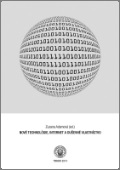Anton Škreko
Full Text of Paper
- Source Type: Publication
- Document Type: Study
- Document Language: Slovak
- Published on: 2014
- File Format: PDF
- File Size: 103 kB
In: ADAMOVÁ, Z. (ed.) Nové technológie, internet a duševné vlastníctvo. Trnava: Typi Universitatis Tyrnaviensis, spoločné pracovisko Trnavskej univerzity v Trnave a VEDY, vydavateľstva Slovenskej akadémie vied, 2014, pp. 90-103. ISBN 978-80-8082-810-3.
Summary: The protection of authors’ rights (copyright) is one of the key stones for the cultural diversity and stimulates what we call the Creative Economy. The legal concepts dealing with the enabling (the permission for) the general public to use the protected subject matters without the need to gain the consent of the author (the license) is immanent part of the copyright rules (so called exceptions and limitations). The Court of the European Union (the Court) recently decided the case C-435/12 (ACI Adam) dealing with the application of the limitation ruled in Art. 5(5)(b) of Directive 2001/29/EC on the harmonisation of certain aspects of copyright and related rights in the information society. The directive rules the limitation to the reproduction right in respect of reproductions on any medium made by a natural person for private use and for ends that are neither directly nor indirectly commercial, on condition that the rightholders receive fair compensation. The judgement says that the EU law, in particular Article 5(2)(b) of Directive 2001/29/EC read in conjunction with paragraph 5 of that article, must be interpreted as precluding national legislation, which does not distinguish the situation in which the source from which a reproduction for private use is made is lawful from that in which that source is unlawful. The present judgement – that is analysed in this article – gives the bright perspective for the national legislation in the field of the reproduction limitation of the copyright. Unlawful source used for reproduction shall not be allowed as the source for the application of this copyright limitation no more. It means that if somebody downloads the protected content from the unlawful source (the source made by breaching the copyright, i.e. without consent of the author), the reproduction limitation shall not apply and one commits the copyright breach. This conclusion emanates from the application of the current EU law using the principle of the fair compensation and three-step-test. Despite the different interpretation of some contexts author of this article comes to similar findings as the Court and at the very end opens some issues closely connected to the findings and conclusions on the current interpretation of the reproduction limitation.
URL: http://ntidv.iuridica.truni.sk/archive/ntidv/NTIDV-Skreko-Anton.pdf
Bibliographic Citation
ŠKREKO, A. Použitie autorského diela na súkromné účely vo svetle aktuálnej judikatúry Súdneho dvora Európskej únie. In: ADAMOVÁ, Z. (ed.) Nové technológie, internet a duševné vlastníctvo. Trnava: Typi Universitatis Tyrnaviensis, spoločné pracovisko Trnavskej univerzity v Trnave a VEDY, vydavateľstva Slovenskej akadémie vied, 2014, pp. 90-103. ISBN 978-80-8082-810-3.
